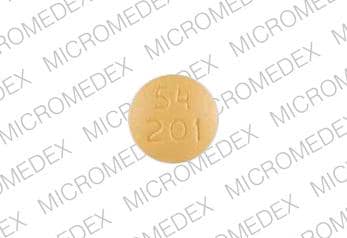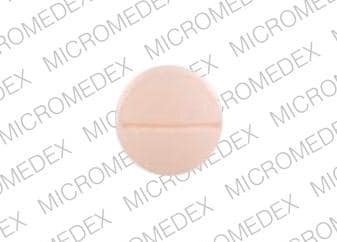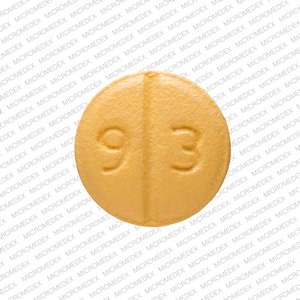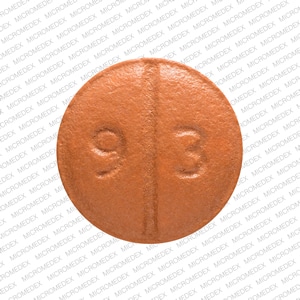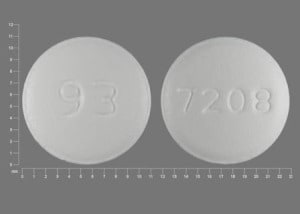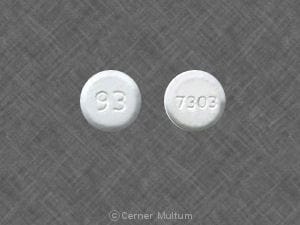Boxed Warning
Suicidality and antidepressant drugs:
Antidepressants increased the risk compared with placebo of suicidal thinking and behavior (suicidality) in children, adolescents, and young adults in short-term studies of major depressive disorder (MDD) and other psychiatric disorders. Anyone considering the use of mirtazapine or any other antidepressant in a child, adolescent, or young adult must balance this risk with the clinical need. Short-term studies did not show an increase in the risk of suicidality with antidepressants compared with placebo in adults older than 24 years; there was a reduction in risk with antidepressants compared with placebo in adults 65 years and older. Depression and certain other psychiatric disorders are associated with increases in suicide risk. Appropriately monitor and closely observe patients of all ages who are started on antidepressant therapy for clinical worsening, suicidality, or unusual changes in behavior. Advise families and caregivers of the need for close observation and communication with the health care provider. Mirtazapine is not approved for use in pediatric patients.
Dosage Forms
Excipient information presented when available (limited, particularly for generics); consult specific product labeling. [DSC] = Discontinued product
Tablet, Oral:
Remeron: 15 mg [scored]
Remeron: 15 mg [scored; contains corn starch]
Remeron: 30 mg [scored]
Remeron: 30 mg [scored; contains corn starch]
Remeron: 45 mg [DSC]
Generic: 7.5 mg, 15 mg, 30 mg, 45 mg
Tablet Disintegrating, Oral:
Remeron SolTab: 15 mg, 30 mg, 45 mg [contains aspartame]
Generic: 15 mg, 30 mg, 45 mg
Pharmacology
Mechanism of Action
Mirtazapine is a tetracyclic antidepressant that works by its central presynaptic alpha2-adrenergic antagonist effects, which results in increased release of norepinephrine and serotonin. It is also a potent antagonist of 5-HT2 and 5-HT3 serotonin receptors and H1 histamine receptors and a moderate peripheral alpha1-adrenergic and muscarinic antagonist; it does not inhibit the reuptake of norepinephrine or serotonin.
Pharmacokinetics/Pharmacodynamics
Absorption
Rapid and complete
Metabolism
Extensively hepatic via CYP1A2, 2D6, 3A4 and via demethylation and hydroxylation
Excretion
Urine (75%) and feces (15%) as metabolites
Time to Peak
Serum: ~2 hours
Half-Life Elimination
20 to 40 hours; increased with renal or hepatic impairment
Protein Binding
~85%
Use in Specific Populations
Special Populations: Renal Function Impairment
Clearance is reduced ~30% in patients with moderate (CrCl 11 to 39 mL/minute) and ~50% in patients with severe (CrCl <10 mL/minute) renal impairment.
Special Populations: Hepatic Function Impairment
Clearance is decreased ~30% in patients with hepatic impairment.
Special Populations: Elderly
Clearance is reduced 40% in elderly men and 10% in elderly women.
Special Populations: Gender
Women have a longer elimination half-life (37 hours) than men (26 hours).
Use: Labeled Indications
Major depressive disorder (unipolar): Treatment of unipolar major depressive disorder (MDD)
Use: Off Label
Headache, chronic tension-type, prophylaxisc
Data from a limited number of patients studied suggest that mirtazapine may be beneficial for the prophylaxis of chronic tension-type headache Bendtsen 2004.
Based on the EFNS guideline on the treatment of tension-type headache, mirtazapine is probably effective and a second-line option for the prophylaxis of chronic tension-type headache.
Panic disorderc
Data from a limited number of patients studied suggest that mirtazapine may be beneficial for the treatment of panic disorder Boshuisen 2001, Carli 2002, Montanes-Rada 2005, Ribeiro 2001, Sarchiapone 2003.
Based on the Canadian clinical practice guidelines for the management of anxiety, posttraumatic stress and obsessive-compulsive disorders, mirtazapine is a second-line treatment option for panic disorder.
Contraindications
Hypersensitivity to mirtazapine or any component of the formulation; use of MAO inhibitors intended to treat psychiatric disorders (concurrently or within 14 days of discontinuing either mirtazapine or the MAO inhibitor); initiation of mirtazapine in a patient receiving linezolid or intravenous methylene blue
Dosage and Administration
Dosing: Adult
Headache, chronic tension-type, prophylaxis (alternative agent) (off-label use): Oral: Initial: 15 mg once daily at bedtime; may increase after 1 week to 30 mg/day based on response and tolerability (Bendtsen 2004)
Major depressive disorder (unipolar): Oral: Initial: 15 mg once daily at bedtime; increase dose in 15 mg increments at intervals no less than every 1 to 2 weeks based on response and tolerability. Maximum dose: 45 mg/day (product labeling); however, doses up to 60 mg/day have been used in clinical trials (VA/DoD 2016; Watanabe 2011).
Panic disorder (alternative agent) (off-label use):
Note: As monotherapy or adjunctive therapy in patients nonresponsive to SSRIs.
Oral: Initial: 15 mg once daily at bedtime; may increase in increments of 15 mg at intervals of no less than 1 week based on response and tolerability, up to a usual maximum of 45 mg once daily (product labeling). Average doses in clinical trials were ~30 mg/day; doses up to 60 mg/day have been evaluated (Boshuisen 2001; Montañés-Rada 2005; Ribeiro 2001).
Discontinuation of therapy: When discontinuing antidepressant treatment that has lasted for >3 weeks, gradually taper the dose (eg, over 2 to 4 weeks) to minimize withdrawal symptoms and detect reemerging symptoms (APA 2010; WFSBP [Bauer 2015]). Reasons for a slower titration (eg, over 4 weeks) include use of a drug with a half-life <24 hours (eg, paroxetine, venlafaxine), prior history of antidepressant withdrawal symptoms, or high doses of antidepressants (APA 2010; Hirsch 2019). If intolerable withdrawal symptoms occur, resume the previously prescribed dose and/or decrease dose at a more gradual rate (Shelton 2001). Select patients (eg, those with a history of discontinuation syndrome) on long-term treatment (>6 months) may benefit from tapering over >3 months (WFSBP [Bauer 2015]). Evidence supporting ideal taper rates is limited (Shelton 2001; WFSBP [Bauer 2015]).
Switching antidepressants: Evidence for ideal antidepressant switching strategies is limited; strategies include cross-titration (gradually discontinuing the first antidepressant while at the same time gradually increasing the new antidepressant) and direct switch (abruptly discontinuing the first antidepressant and then starting the new antidepressant at an equivalent dose or lower dose and increasing it gradually). Cross-titration (eg, over 1 to 4 weeks depending upon sensitivity to discontinuation symptoms and adverse effects) is standard for most switches, but is contraindicated when switching to or from an MAOI. A direct switch may be an appropriate approach when switching to another agent in the same or similar class (eg, when switching between two SSRIs), when the antidepressant to be discontinued has been used for <1 week, or when the discontinuation is for adverse effects. When choosing the switch strategy, consider the risk of discontinuation symptoms, potential for drug interactions, other antidepressant properties (eg, half-life, adverse effects, and pharmacodynamics), and the degree of symptom control desired (WFSBP [Bauer 2013]; Hirsch 2018; Ogle 2013).
Switching to or from an MAOI:
Allow 14 days to elapse between discontinuing an MAOI and initiation of mirtazapine.
Allow 14 days to elapse between discontinuing mirtazapine and initiation of an MAOI.
Dosing: Geriatric
Major depressive disorder (unipolar): Oral: Initial starting doses of 7.5 mg once daily at bedtime have been suggested (VA/DoD 2016). Use with caution; clearance may be reduced; refer to adult dosing. Note: Some experts consider mirtazapine to be useful for stimulating appetite in older adults with depression and weight loss (Ritchie 2018).
Discontinuation of therapy: Refer to adult dosing.
Switching antidepressants: Refer to adult dosing.
Administration
Oral: Administer without regard to meals.
Orally disintegrating tablet: Open blister pack and place tablet on the tongue; tablet is formulated to dissolve on the tongue without water; do not split tablet.
Dietary Considerations
Some products may contain phenylalanine.
Storage
Store at 25°C (77°F); excursions are permitted between 15°C and 30°C (59°F and 86°F). Protect from light and moisture. Use orally disintegrating tablets immediately upon opening individual tablet blister; once removed it cannot be stored.
Mirtazapine Images
Drug Interactions
Alcohol (Ethyl): May enhance the CNS depressant effect of Mirtazapine. Avoid combination
Alizapride: May enhance the CNS depressant effect of CNS Depressants. Monitor therapy
Almotriptan: May enhance the serotonergic effect of Serotonergic Agents (High Risk). This could result in serotonin syndrome. Management: Monitor for signs and symptoms of serotonin syndrome/serotonin toxicity (eg, hyperreflexia, clonus, hyperthermia, diaphoresis, tremor, autonomic instability, mental status changes) when these agents are combined. Monitor therapy
Alosetron: May enhance the serotonergic effect of Serotonergic Agents (High Risk). This could result in serotonin syndrome. Management: Monitor for signs and symptoms of serotonin syndrome/serotonin toxicity (eg, hyperreflexia, clonus, hyperthermia, diaphoresis, tremor, autonomic instability, mental status changes) when these agents are combined. Monitor therapy
Alpha2-Agonists: Mirtazapine may diminish the antihypertensive effect of Alpha2-Agonists. Management: Consider avoiding concurrent use. If the combination cannot be avoided, monitor for decreased effects of alpha2-agonists if mirtazapine is initiated/dose increased, or increased effects if mirtazapine is discontinued/dose decreased. Consider therapy modification
Amphetamines: May enhance the serotonergic effect of Serotonergic Agents (High Risk). This could result in serotonin syndrome. Management: Monitor for signs and symptoms of serotonin syndrome/serotonin toxicity (eg, hyperreflexia, clonus, hyperthermia, diaphoresis, tremor, autonomic instability, mental status changes) when these agents are combined. Monitor therapy
Antiemetics (5HT3 Antagonists): May enhance the serotonergic effect of Serotonergic Agents (High Risk). This could result in serotonin syndrome. Management: Monitor for signs and symptoms of serotonin syndrome/serotonin toxicity (eg, hyperreflexia, clonus, hyperthermia, diaphoresis, tremor, autonomic instability, mental status changes) when these agents are combined. Exceptions: Alosetron; Ondansetron; Ramosetron. Monitor therapy
Antipsychotic Agents: Serotonergic Agents (High Risk) may enhance the adverse/toxic effect of Antipsychotic Agents. Specifically, serotonergic agents may enhance dopamine blockade, possibly increasing the risk for neuroleptic malignant syndrome. Antipsychotic Agents may enhance the serotonergic effect of Serotonergic Agents (High Risk). This could result in serotonin syndrome. Monitor therapy
Aprepitant: May increase the serum concentration of CYP3A4 Substrates (High risk with Inhibitors). Monitor therapy
Azelastine (Nasal): CNS Depressants may enhance the CNS depressant effect of Azelastine (Nasal). Avoid combination
Blonanserin: CNS Depressants may enhance the CNS depressant effect of Blonanserin. Consider therapy modification
Bosentan: May decrease the serum concentration of CYP3A4 Substrates (High risk with Inducers). Monitor therapy
Brexanolone: CNS Depressants may enhance the CNS depressant effect of Brexanolone. Monitor therapy
Brimonidine (Topical): May enhance the CNS depressant effect of CNS Depressants. Monitor therapy
Bromopride: May enhance the CNS depressant effect of CNS Depressants. Monitor therapy
Bromperidol: May enhance the CNS depressant effect of CNS Depressants. Avoid combination
Buprenorphine: CNS Depressants may enhance the CNS depressant effect of Buprenorphine. Management: Consider reduced doses of other CNS depressants, and avoiding such drugs in patients at high risk of buprenorphine overuse/self-injection. Initiate buprenorphine at lower doses in patients already receiving CNS depressants. Consider therapy modification
BusPIRone: May enhance the serotonergic effect of Serotonergic Agents (High Risk). This could result in serotonin syndrome. Management: Monitor for signs and symptoms of serotonin syndrome/serotonin toxicity (eg, hyperreflexia, clonus, hyperthermia, diaphoresis, tremor, autonomic instability, mental status changes) when these agents are combined. Monitor therapy
Cannabidiol: May enhance the CNS depressant effect of CNS Depressants. Monitor therapy
Cannabis: May enhance the CNS depressant effect of CNS Depressants. Monitor therapy
Chlormethiazole: May enhance the CNS depressant effect of CNS Depressants. Management: Monitor closely for evidence of excessive CNS depression. The chlormethiazole labeling states that an appropriately reduced dose should be used if such a combination must be used. Consider therapy modification
Chlorphenesin Carbamate: May enhance the adverse/toxic effect of CNS Depressants. Monitor therapy
Cimetidine: May increase the serum concentration of Mirtazapine. Monitor therapy
Clofazimine: May increase the serum concentration of CYP3A4 Substrates (High risk with Inhibitors). Monitor therapy
CNS Depressants: May enhance the adverse/toxic effect of other CNS Depressants. Monitor therapy
Conivaptan: May increase the serum concentration of CYP3A4 Substrates (High risk with Inhibitors). Avoid combination
Cyclobenzaprine: May enhance the serotonergic effect of Serotonergic Agents (High Risk). This could result in serotonin syndrome. Management: Monitor for signs and symptoms of serotonin syndrome/serotonin toxicity (eg, hyperreflexia, clonus, hyperthermia, diaphoresis, tremor, autonomic instability, mental status changes) when these agents are combined. Monitor therapy
CYP3A4 Inducers (Moderate): May decrease the serum concentration of CYP3A4 Substrates (High risk with Inducers). Monitor therapy
CYP3A4 Inducers (Strong): May decrease the serum concentration of Mirtazapine. Monitor therapy
CYP3A4 Inhibitors (Moderate): May decrease the metabolism of CYP3A4 Substrates (High risk with Inhibitors). Monitor therapy
CYP3A4 Inhibitors (Strong): May increase the serum concentration of Mirtazapine. Exceptions: Nefazodone. Monitor therapy
Dabrafenib: May decrease the serum concentration of CYP3A4 Substrates (High risk with Inducers). Management: Seek alternatives to the CYP3A4 substrate when possible. If concomitant therapy cannot be avoided, monitor clinical effects of the substrate closely (particularly therapeutic effects). Consider therapy modification
Dapoxetine: May enhance the serotonergic effect of Serotonergic Agents (High Risk). This could result in serotonin syndrome. Management: Do not use serotonergic agents (high risk) with dapoxetine or within 7 days of serotonergic agent discontinuation. Do not use dapoxetine within 14 days of monoamine oxidase inhibitor use. Dapoxetine labeling lists this combination as contraindicated. Avoid combination
Deferasirox: May decrease the serum concentration of CYP3A4 Substrates (High risk with Inducers). Monitor therapy
Dexmethylphenidate-Methylphenidate: May enhance the serotonergic effect of Serotonergic Agents (High Risk). This could result in serotonin syndrome. Management: Monitor for signs and symptoms of serotonin syndrome/serotonin toxicity (eg, hyperreflexia, clonus, hyperthermia, diaphoresis, tremor, autonomic instability, mental status changes) when these agents are combined. Monitor therapy
Dextromethorphan: May enhance the serotonergic effect of Serotonergic Agents (High Risk). This could result in serotonin syndrome. Management: Monitor for signs and symptoms of serotonin syndrome/serotonin toxicity (eg, hyperreflexia, clonus, hyperthermia, diaphoresis, tremor, autonomic instability, mental status changes) when these agents are combined. Monitor therapy
Dimethindene (Topical): May enhance the CNS depressant effect of CNS Depressants. Monitor therapy
Doxylamine: May enhance the CNS depressant effect of CNS Depressants. Management: The manufacturer of Diclegis (doxylamine/pyridoxine), intended for use in pregnancy, specifically states that use with other CNS depressants is not recommended. Monitor therapy
Dronabinol: May enhance the CNS depressant effect of CNS Depressants. Monitor therapy
Droperidol: May enhance the CNS depressant effect of CNS Depressants. Management: Consider dose reductions of droperidol or of other CNS agents (eg, opioids, barbiturates) with concomitant use. Exceptions to this monograph are discussed in further detail in separate drug interaction monographs. Consider therapy modification
Duvelisib: May increase the serum concentration of CYP3A4 Substrates (High risk with Inhibitors). Monitor therapy
Eletriptan: May enhance the serotonergic effect of Serotonergic Agents (High Risk). This could result in serotonin syndrome. Management: Monitor for signs and symptoms of serotonin syndrome/serotonin toxicity (eg, hyperreflexia, clonus, hyperthermia, diaphoresis, tremor, autonomic instability, mental status changes) when these agents are combined. Monitor therapy
Enzalutamide: May decrease the serum concentration of CYP3A4 Substrates (High risk with Inducers). Management: Concurrent use of enzalutamide with CYP3A4 substrates that have a narrow therapeutic index should be avoided. Use of enzalutamide and any other CYP3A4 substrate should be performed with caution and close monitoring. Consider therapy modification
Erdafitinib: May decrease the serum concentration of CYP3A4 Substrates (High risk with Inducers). Monitor therapy
Erdafitinib: May increase the serum concentration of CYP3A4 Substrates (High risk with Inhibitors). Monitor therapy
Ergot Derivatives: May enhance the serotonergic effect of Serotonergic Agents (High Risk). This could result in serotonin syndrome. Management: Monitor for signs and symptoms of serotonin syndrome/serotonin toxicity (eg, hyperreflexia, clonus, hyperthermia, diaphoresis, tremor, autonomic instability, mental status changes) when these agents are combined. Exceptions: Nicergoline. Monitor therapy
Esketamine: May enhance the CNS depressant effect of CNS Depressants. Monitor therapy
Flunitrazepam: CNS Depressants may enhance the CNS depressant effect of Flunitrazepam. Consider therapy modification
Fosaprepitant: May increase the serum concentration of CYP3A4 Substrates (High risk with Inhibitors). Monitor therapy
Fosnetupitant: May increase the serum concentration of CYP3A4 Substrates (High risk with Inhibitors). Monitor therapy
Fusidic Acid (Systemic): May increase the serum concentration of CYP3A4 Substrates (High risk with Inhibitors). Avoid combination
Haloperidol: QT-prolonging Agents (Indeterminate Risk - Caution) may enhance the QTc-prolonging effect of Haloperidol. Monitor therapy
HYDROcodone: CNS Depressants may enhance the CNS depressant effect of HYDROcodone. Management: Avoid concomitant use of hydrocodone and benzodiazepines or other CNS depressants when possible. These agents should only be combined if alternative treatment options are inadequate. If combined, limit the dosages and duration of each drug. Consider therapy modification
HydrOXYzine: May enhance the CNS depressant effect of CNS Depressants. Monitor therapy
Idelalisib: May increase the serum concentration of CYP3A4 Substrates (High risk with Inhibitors). Avoid combination
Ivosidenib: May decrease the serum concentration of CYP3A4 Substrates (High risk with Inducers). Monitor therapy
Kava Kava: May enhance the adverse/toxic effect of CNS Depressants. Monitor therapy
Larotrectinib: May increase the serum concentration of CYP3A4 Substrates (High risk with Inhibitors). Monitor therapy
Lasmiditan: May enhance the serotonergic effect of Serotonergic Agents (High Risk). This could result in serotonin syndrome. Management: Monitor for signs and symptoms of serotonin syndrome/serotonin toxicity (eg, hyperreflexia, clonus, hyperthermia, diaphoresis, tremor, autonomic instability, mental status changes) when these agents are combined. Monitor therapy
Lemborexant: May enhance the CNS depressant effect of CNS Depressants. Management: Dosage adjustments of lemborexant and of concomitant CNS depressants may be necessary when administered together because of potentially additive CNS depressant effects. Close monitoring for CNS depressant effects is necessary. Consider therapy modification
Linezolid: May enhance the serotonergic effect of Serotonergic Non-Opioid CNS Depressants. This could result in serotonin syndrome. Avoid combination
Lorcaserin: May enhance the serotonergic effect of Serotonergic Agents (High Risk). This could result in serotonin syndrome. Management: Monitor for signs and symptoms of serotonin syndrome/serotonin toxicity (eg, hyperreflexia, clonus, hyperthermia, diaphoresis, tremor, autonomic instability, mental status changes) when these agents are combined. Monitor therapy
Lorlatinib: May decrease the serum concentration of CYP3A4 Substrates (High risk with Inducers). Management: Avoid concurrent use of lorlatinib with any CYP3A4 substrates for which a minimal decrease in serum concentrations of the CYP3A4 substrate could lead to therapeutic failure and serious clinical consequences. Consider therapy modification
Magnesium Sulfate: May enhance the CNS depressant effect of CNS Depressants. Monitor therapy
Metaxalone: May enhance the serotonergic effect of Serotonergic Agents (High Risk). This could result in serotonin syndrome. Management: Monitor for signs and symptoms of serotonin syndrome/serotonin toxicity (eg, hyperreflexia, clonus, hyperthermia, diaphoresis, tremor, autonomic instability, mental status changes) when these agents are combined. Monitor therapy
Methotrimeprazine: CNS Depressants may enhance the CNS depressant effect of Methotrimeprazine. Methotrimeprazine may enhance the CNS depressant effect of CNS Depressants. Management: Reduce adult dose of CNS depressant agents by 50% with initiation of concomitant methotrimeprazine therapy. Further CNS depressant dosage adjustments should be initiated only after clinically effective methotrimeprazine dose is established. Consider therapy modification
Methylene Blue: Serotonergic Non-Opioid CNS Depressants may enhance the serotonergic effect of Methylene Blue. This could result in serotonin syndrome. Avoid combination
MetyroSINE: CNS Depressants may enhance the sedative effect of MetyroSINE. Monitor therapy
MiFEPRIStone: May increase the serum concentration of CYP3A4 Substrates (High risk with Inhibitors). Management: Minimize doses of CYP3A4 substrates, and monitor for increased concentrations/toxicity, during and 2 weeks following treatment with mifepristone. Avoid cyclosporine, dihydroergotamine, ergotamine, fentanyl, pimozide, quinidine, sirolimus, and tacrolimus. Consider therapy modification
Minocycline (Systemic): May enhance the CNS depressant effect of CNS Depressants. Monitor therapy
Mitotane: May decrease the serum concentration of CYP3A4 Substrates (High risk with Inducers). Management: Doses of CYP3A4 substrates may need to be adjusted substantially when used in patients being treated with mitotane. Consider therapy modification
Monoamine Oxidase Inhibitors (Antidepressant): Serotonergic Non-Opioid CNS Depressants may enhance the serotonergic effect of Monoamine Oxidase Inhibitors (Antidepressant). This could result in serotonin syndrome. Avoid combination
Nabilone: May enhance the CNS depressant effect of CNS Depressants. Monitor therapy
Nefazodone: Mirtazapine may enhance the serotonergic effect of Nefazodone. This could result in serotonin syndrome. Nefazodone may increase the serum concentration of Mirtazapine. Management: Monitor for signs and symptoms of serotonin syndrome/serotonin toxicity (eg, hyperreflexia, clonus, hyperthermia, diaphoresis, tremor, autonomic instability, mental status changes) and for increased mirtazapine toxicities when these agents are combined. Monitor therapy
Netupitant: May increase the serum concentration of CYP3A4 Substrates (High risk with Inhibitors). Monitor therapy
Ondansetron: May enhance the serotonergic effect of Serotonergic Agents (High Risk). This could result in serotonin syndrome. Management: Monitor for signs and symptoms of serotonin syndrome/serotonin toxicity (eg, hyperreflexia, clonus, hyperthermia, diaphoresis, tremor, autonomic instability, mental status changes) when these agents are combined. Monitor therapy
Opioid Agonists: CNS Depressants may enhance the CNS depressant effect of Opioid Agonists. Management: Avoid concomitant use of opioid agonists and benzodiazepines or other CNS depressants when possible. These agents should only be combined if alternative treatment options are inadequate. If combined, limit the dosages and duration of each drug. Consider therapy modification
Orphenadrine: CNS Depressants may enhance the CNS depressant effect of Orphenadrine. Avoid combination
Oxitriptan: Serotonergic Agents (High Risk) may enhance the serotonergic effect of Oxitriptan. This could result in serotonin syndrome. Management: Monitor for signs and symptoms of serotonin syndrome/serotonin toxicity (eg, hyperreflexia, clonus, hyperthermia, diaphoresis, tremor, autonomic instability, mental status changes) when these agents are combined. Monitor therapy
Oxomemazine: May enhance the CNS depressant effect of CNS Depressants. Avoid combination
OxyCODONE: CNS Depressants may enhance the CNS depressant effect of OxyCODONE. Management: Avoid concomitant use of oxycodone and benzodiazepines or other CNS depressants when possible. These agents should only be combined if alternative treatment options are inadequate. If combined, limit the dosages and duration of each drug. Consider therapy modification
Palbociclib: May increase the serum concentration of CYP3A4 Substrates (High risk with Inhibitors). Monitor therapy
Paraldehyde: CNS Depressants may enhance the CNS depressant effect of Paraldehyde. Avoid combination
Perampanel: May enhance the CNS depressant effect of CNS Depressants. Management: Patients taking perampanel with any other drug that has CNS depressant activities should avoid complex and high-risk activities, particularly those such as driving that require alertness and coordination, until they have experience using the combination. Consider therapy modification
Piribedil: CNS Depressants may enhance the CNS depressant effect of Piribedil. Monitor therapy
Pitolisant: Mirtazapine may diminish the therapeutic effect of Pitolisant. Avoid combination
Pramipexole: CNS Depressants may enhance the sedative effect of Pramipexole. Monitor therapy
QT-prolonging Agents (Highest Risk): QT-prolonging Agents (Indeterminate Risk - Caution) may enhance the QTc-prolonging effect of QT-prolonging Agents (Highest Risk). Management: Monitor for QTc interval prolongation and ventricular arrhythmias when these agents are combined. Patients with additional risk factors for QTc prolongation may be at even higher risk. Monitor therapy
Ramosetron: May enhance the serotonergic effect of Serotonergic Agents (High Risk). This could result in serotonin syndrome. Management: Monitor for signs and symptoms of serotonin syndrome/serotonin toxicity (eg, hyperreflexia, clonus, hyperthermia, diaphoresis, tremor, autonomic instability, mental status changes) when these agents are combined. Monitor therapy
Rasagiline: May enhance the serotonergic effect of Serotonergic Non-Opioid CNS Depressants. This could result in serotonin syndrome. Avoid combination
ROPINIRole: CNS Depressants may enhance the sedative effect of ROPINIRole. Monitor therapy
Rotigotine: CNS Depressants may enhance the sedative effect of Rotigotine. Monitor therapy
Rufinamide: May enhance the adverse/toxic effect of CNS Depressants. Specifically, sleepiness and dizziness may be enhanced. Monitor therapy
Safinamide: May enhance the serotonergic effect of Serotonergic Non-Opioid CNS Depressants. This could result in serotonin syndrome. Avoid combination
Sarilumab: May decrease the serum concentration of CYP3A4 Substrates (High risk with Inducers). Monitor therapy
Selective Serotonin Reuptake Inhibitors: CNS Depressants may enhance the adverse/toxic effect of Selective Serotonin Reuptake Inhibitors. Specifically, the risk of psychomotor impairment may be enhanced. Monitor therapy
Selective Serotonin Reuptake Inhibitors: May enhance the serotonergic effect of Serotonergic Non-Opioid CNS Depressants. This could result in serotonin syndrome. Management: Monitor for signs and symptoms of serotonin syndrome/serotonin toxicity (eg, hyperreflexia, clonus, hyperthermia, diaphoresis, tremor, autonomic instability, mental status changes) when these agents are combined. Exceptions: Dapoxetine. Monitor therapy
Selegiline: May enhance the serotonergic effect of Serotonergic Non-Opioid CNS Depressants. This could result in serotonin syndrome. Avoid combination
Serotonergic Agents (High Risk, Miscellaneous): May enhance the serotonergic effect of Serotonergic Non-Opioid CNS Depressants. This could result in serotonin syndrome. Management: Monitor for signs and symptoms of serotonin syndrome/serotonin toxicity (eg, hyperreflexia, clonus, hyperthermia, diaphoresis, tremor, autonomic instability, mental status changes) when these agents are combined. Monitor therapy
Serotonergic Opioids (High Risk): Serotonergic Non-Opioid CNS Depressants may enhance the CNS depressant effect of Serotonergic Opioids (High Risk). Serotonergic Non-Opioid CNS Depressants may enhance the serotonergic effect of Serotonergic Opioids (High Risk). This could result in serotonin syndrome. Management: Consider alternatives to this drug combination. If combined, monitor for signs and symptoms of serotonin syndrome/serotonin toxicity and CNS depression. Consider therapy modification
Serotonin 5-HT1D Receptor Agonists (Triptans): May enhance the serotonergic effect of Serotonergic Agents (High Risk). This could result in serotonin syndrome. Management: Monitor for signs and symptoms of serotonin syndrome/serotonin toxicity (eg, hyperreflexia, clonus, hyperthermia, diaphoresis, tremor, autonomic instability, mental status changes) when these agents are combined. Exceptions: Almotriptan; Eletriptan. Monitor therapy
Serotonin/Norepinephrine Reuptake Inhibitors: Mirtazapine may enhance the serotonergic effect of Serotonin/Norepinephrine Reuptake Inhibitors. This could result in serotonin syndrome. Management: Monitor for signs and symptoms of serotonin syndrome/serotonin toxicity (eg, hyperreflexia, clonus, hyperthermia, diaphoresis, tremor, autonomic instability, mental status changes) when these agents are combined. Monitor therapy
Siltuximab: May decrease the serum concentration of CYP3A4 Substrates (High risk with Inducers). Monitor therapy
Simeprevir: May increase the serum concentration of CYP3A4 Substrates (High risk with Inhibitors). Monitor therapy
Sodium Oxybate: May enhance the CNS depressant effect of CNS Depressants. Management: Consider alternatives to combined use. When combined use is needed, consider minimizing doses of one or more drugs. Use of sodium oxybate with alcohol or sedative hypnotics is contraindicated. Consider therapy modification
St John's Wort: May enhance the serotonergic effect of Serotonergic Agents (High Risk). This could result in serotonin syndrome. St John's Wort may decrease the serum concentration of Serotonergic Agents (High Risk). Management: Monitor for signs and symptoms of serotonin syndrome/serotonin toxicity (eg, hyperreflexia, clonus, hyperthermia, diaphoresis, tremor, autonomic instability, mental status changes) when these agents are combined. Monitor therapy
Stiripentol: May increase the serum concentration of CYP3A4 Substrates (High risk with Inhibitors). Management: Use of stiripentol with CYP3A4 substrates that are considered to have a narrow therapeutic index should be avoided due to the increased risk for adverse effects and toxicity. Any CYP3A4 substrate used with stiripentol requires closer monitoring. Consider therapy modification
Suvorexant: CNS Depressants may enhance the CNS depressant effect of Suvorexant. Management: Dose reduction of suvorexant and/or any other CNS depressant may be necessary. Use of suvorexant with alcohol is not recommended, and the use of suvorexant with any other drug to treat insomnia is not recommended. Consider therapy modification
Syrian Rue: May enhance the serotonergic effect of Serotonergic Agents (High Risk). This could result in serotonin syndrome. Management: Monitor for signs and symptoms of serotonin syndrome/serotonin toxicity (eg, hyperreflexia, clonus, hyperthermia, diaphoresis, tremor, autonomic instability, mental status changes) when these agents are combined. Monitor therapy
Tapentadol: May enhance the CNS depressant effect of CNS Depressants. Management: Avoid concomitant use of tapentadol and benzodiazepines or other CNS depressants when possible. These agents should only be combined if alternative treatment options are inadequate. If combined, limit the dosages and duration of each drug. Consider therapy modification
Tetrahydrocannabinol: May enhance the CNS depressant effect of CNS Depressants. Monitor therapy
Tetrahydrocannabinol and Cannabidiol: May enhance the CNS depressant effect of CNS Depressants. Monitor therapy
Thalidomide: CNS Depressants may enhance the CNS depressant effect of Thalidomide. Avoid combination
Tobacco (Smoked): May decrease the serum concentration of Mirtazapine. Monitor therapy
Tocilizumab: May decrease the serum concentration of CYP3A4 Substrates (High risk with Inducers). Monitor therapy
TraZODone: May enhance the CNS depressant effect of Mirtazapine. TraZODone may enhance the serotonergic effect of Mirtazapine. This could result in serotonin syndrome. Management: Monitor for signs and symptoms of serotonin syndrome/serotonin toxicity (eg, hyperreflexia, clonus, hyperthermia, diaphoresis, tremor, autonomic instability, mental status changes) and CNS depression when these agents are combined. Monitor therapy
Tricyclic Antidepressants: May enhance the CNS depressant effect of Serotonergic Non-Opioid CNS Depressants. Tricyclic Antidepressants may enhance the serotonergic effect of Serotonergic Non-Opioid CNS Depressants. This could result in serotonin syndrome. Management: Monitor for signs and symptoms of serotonin syndrome/serotonin toxicity (eg, hyperreflexia, clonus, hyperthermia, diaphoresis, tremor, autonomic instability, mental status changes) and CNS depression when these agents are combined. Monitor therapy
Trimeprazine: May enhance the CNS depressant effect of CNS Depressants. Monitor therapy
Warfarin: Mirtazapine may enhance the anticoagulant effect of Warfarin. Monitor therapy
Zolpidem: CNS Depressants may enhance the CNS depressant effect of Zolpidem. Management: Reduce the Intermezzo brand sublingual zolpidem adult dose to 1.75 mg for men who are also receiving other CNS depressants. No such dose change is recommended for women. Avoid use with other CNS depressants at bedtime; avoid use with alcohol. Consider therapy modification
Adverse Reactions
>10%:
Central nervous system: Drowsiness (54%)
Endocrine & metabolic: Weight gain (12%; weight gain of >7% reported in 8% of adults, 49% of pediatric patients), increased serum cholesterol (15%)
Gastrointestinal: Xerostomia (25%), increased appetite (17%), constipation (13%)
1% to 10%:
Cardiovascular: Peripheral edema (2%), edema (1%), hypertension, vasodilation
Central nervous system: Dizziness (7%), abnormal dreams (4%), abnormality in thinking (3%), confusion (2%), agitation, amnesia, anxiety, apathy, depression, hypoesthesia, malaise, myasthenia, paresthesia, twitching, vertigo
Dermatologic: Pruritus, skin rash
Endocrine & metabolic: Increased serum triglycerides (6%), increased thirst
Gastrointestinal: Abdominal pain, acute abdominal condition, anorexia, vomiting
Genitourinary: Urinary frequency (2%), urinary tract infection
Hepatic: Increased serum alanine aminotransferase (≥3 times ULN: 2%)
Neuromuscular & skeletal: Asthenia (8%), back pain (2%), myalgia (2%), tremor (2%), arthralgia, hyperkinetic muscle activity, hypokinesia
Respiratory: Flu-like symptoms (5%), dyspnea (1%), increased cough, sinusitis
Frequency not defined:
Cardiovascular: Orthostatic hypotension
<1%, postmarketing, and/or case reports: Abnormal accommodation, abnormal healing, abnormal hepatic function tests, abnormal lacrimation, acne vulgaris, acute myocardial infarction, ageusia, agranulocytosis, akathisia, alopecia, altered sense of smell, amenorrhea, anemia, angina pectoris, angle-closure glaucoma, aphasia, aphthous stomatitis, arthritis, asphyxia, asthma, ataxia, atrial arrhythmia, bigeminy, blepharitis, bone fracture, bradycardia, breast engorgement, breast hypertrophy, bronchitis, bullous dermatitis, bursitis, cardiomegaly, cellulitis, cerebral ischemia, chest pain, chills, cholecystitis, colitis, complex sleep-related disorder, conjunctivitis, cystitis, deafness, dehydration, delirium, delusion, dementia, depersonalization, dermal ulcer, diabetes mellitus, diplopia, drug dependence, dysarthria, dyskinesia, dysmenorrhea, dystonia, dysuria, ejaculatory disorder, emotional lability, enlargement of abdomen, enlargement of salivary glands, epistaxis, eructation, erythema multiforme, euphoria, exfoliative dermatitis, extrapyramidal reaction, eye pain, facial edema, fever, gastritis, gastroenteritis, gingival hemorrhage, glossitis, goiter, gout, hallucination, heavy menstrual bleeding, hematuria, hepatic cirrhosis, herpes simplex infection, herpes zoster infection, hiccups, hostility, hyperacusis, hyperprolactinemia, hyperreflexia, hypomania, hyponatremia, hypotension, hypothyroidism, hypotonia, impotence, increased acid phosphatase, increased libido, increased serum aspartate aminotransferase, increased serum creatine kinase, intestinal obstruction, keratoconjunctivitis, laryngitis, left ventricular failure, leukopenia, leukorrhea, lymphadenopathy, lymphocytosis, manic reaction, mastalgia, migraine, myoclonus, myositis, nausea, neck pain, neck stiffness, nephrolithiasis, nystagmus disorder, oral candidiasis, ostealgia, osteoarthritis, osteoporosis, otalgia, otitis media, pancreatitis, pancytopenia, paralysis, paranoid ideation, petechia, phlebitis, pneumonia, pneumothorax, polyuria, prolonged QT interval on ECG, psychomotor agitation, psychoneurosis, psychotic depression, pulmonary embolism, rhabdomyolysis, rupture of tendon, seborrhea, seizure, serotonin syndrome, severe neutropenia, sialorrhea, skin hypertrophy, skin photosensitivity, somnambulism, Stevens-Johnson syndrome, stomatitis, stupor, suicidal ideation, suicidal tendencies, syncope, tenosynovitis, thrombocytopenia, tongue discoloration, tongue edema, tonic clonic epilepsy, torsades de pointes, toxic epidermal necrolysis, ulcer, urethritis, urinary incontinence, urinary retention, urinary urgency, urticaria, uterine hemorrhage, vaginitis, vascular headache, ventricular premature contractions, ventricular tachycardia, weight loss, withdrawal syndrome, xeroderma
Warnings/Precautions
Major psychiatric warnings:
- Suicidal thinking/behavior: [US Boxed Warning]: Antidepressants increase the risk of suicidal thinking and behavior in children, adolescents, and young adults (18 to 24 years of age) with major depressive disorder (MDD) and other psychiatric disorders; consider risk prior to prescribing. Short-term studies did not show an increased risk in patients >24 years of age and showed a decreased risk in patients ≥65 years. Closely monitor patients for clinical worsening, suicidality, or unusual changes in behavior, particularly during the initial 1 to 2 months of therapy or during periods of dosage adjustments (increases or decreases); the patient's family or caregiver should be instructed to closely observe the patient and communicate condition with health care provider. A medication guide concerning the use of antidepressants should be dispensed with each prescription. Mirtazapine is not FDA approved for use in children.
- The possibility of a suicide attempt is inherent in major depression and may persist until remission occurs. Worsening depression and severe abrupt suicidality that are not part of the presenting symptoms may require discontinuation or modification of drug therapy. Use caution in high-risk patients during initiation of therapy.
- Prescriptions should be written for the smallest quantity consistent with good patient care. The patient's family or caregiver should be alerted to monitor patients for the emergence of suicidality and associated behaviors such as anxiety, agitation, panic attacks, insomnia, irritability, hostility, impulsivity, akathisia, hypomania, and mania; patients should be instructed to notify their healthcare provider if any of these symptoms or worsening depression occur.
Concerns related to adverse effects:
- Akathisia/psychomotor restlessness: Most likely to occur within first few weeks of treatment and characterized by unpleasant or distressing restlessness and need to move often accompanied by an inability to sit or stand still. Increasing the dose in these patients may be detrimental.
- Anticholinergic effects: May cause anticholinergic effects (constipation, xerostomia, blurred vision, urinary retention); use with caution in patients with decreased gastrointestinal motility, paralytic ileus, urinary retention, BPH, xerostomia, or visual problems. The degree of anticholinergic blockade produced by this agent is low relative to other antidepressants.
- Arrhythmias: QT prolongation, torsade de pointes, and ventricular fibrillation have been reported (rarely); case reports are mostly associated with mirtazapine overdose (although one case series of single-agent mirtazapine overdose in 84 patients did not identify any cases of QT prolongation [Berling 2014]) or patients with risk factors for QT prolongation or receiving concomitant QT-prolonging agents. Use caution in patients with cardiovascular disease, history of QT prolongation, or receiving concomitant QT-prolonging agents.
- Blood dyscrasias: Discontinue immediately if signs and symptoms of neutropenia/agranulocytosis occur.
- CNS depression: May cause CNS depression, which may impair physical or mental abilities; patients must be cautioned about performing tasks that require mental alertness (eg, operating machinery or driving). The degree of sedation is moderate to high relative to other antidepressants.
- Dizziness: Dizziness may occur; it is unclear whether or not tolerance may develop to dizziness.
- Fractures: Bone fractures have been associated with antidepressant treatment. Consider the possibility of a fragility fracture if an antidepressant-treated patient presents with unexplained bone pain, point tenderness, swelling, or bruising (Rabenda 2013; Rizzoli 2012).
- Hyperlipidemia: May increase serum cholesterol and triglyceride levels.
- Hyponatremia: May cause hyponatremia. Use caution in patients at risk, such as elderly or patients concomitantly treated with medications known to cause hyponatremia.
- Ocular effects: May cause mild pupillary dilation which in susceptible individuals can lead to an episode of narrow-angle glaucoma. Consider evaluating patients who have not had an iridectomy for narrow-angle glaucoma risk factors.
- Orthostatic hypotension: May cause orthostatic hypotension (risk is low relative to other antidepressants); use with caution in patients at risk of this effect or in those who would not tolerate transient hypotensive episodes (cerebrovascular disease, cardiovascular disease, dehydration, hypovolemia, or concurrent medication use which may predispose to hypotension/bradycardia).
- Serotonin syndrome: Potentially life-threatening serotonin syndrome (SS) has occurred with serotonergic agents (eg, SSRIs, SNRIs), particularly when used in combination with other serotonergic agents (eg, triptans, TCAs, fentanyl, lithium, tramadol, buspirone, St John's wort, tryptophan) or agents that impair metabolism of serotonin (eg, MAO inhibitors intended to treat psychiatric disorders, other MAO inhibitors [ie, linezolid and intravenous methylene blue]). Monitor patients closely for signs of SS such as mental status changes (eg, agitation, hallucinations, delirium, coma); autonomic instability (eg, tachycardia, labile blood pressure, diaphoresis); neuromuscular changes (eg, tremor, rigidity, myoclonus); GI symptoms (eg, nausea, vomiting, diarrhea); and/or seizures. Discontinue treatment (and any concomitant serotonergic agent) immediately if signs/symptoms arise.
- Sexual dysfunction: The incidence of sexual dysfunction with mirtazapine is generally lower than with SSRIs (Bauer 2013).
- Weight gain: May increase appetite and stimulate weight gain.
Disease-related concerns:
- Hepatic impairment: Use with caution in patients with hepatic impairment. Clinically significant transaminase elevations have been observed.
- Mania/hypomania: May precipitate a shift to mania or hypomania in patients with bipolar disorder. Monotherapy in patients with bipolar disorder should be avoided. Patients presenting with depressive symptoms should be screened for bipolar disorder, including details regarding family history of suicide, bipolar disorder, and depression. Mirtazapine is not FDA approved for the treatment of bipolar depression.
- Renal impairment: Use with caution in patients with renal impairment; clearance is decreased with moderate and severe renal impairment.
- Seizure disorder: Use with caution in patients at risk of seizures, including those with a history of seizures, head trauma, brain damage, alcoholism, or concurrent therapy with medications which may lower seizure threshold.
Concurrent drug therapy issues:
- Drug-drug interactions: Potentially significant interactions may exist, requiring dose or frequency adjustment, additional monitoring, and/or selection of alternative therapy. Consult drug interactions database for more detailed information.
Dosage form specific issues:
- Lactose: Tablets may contain lactose.
- Phenylalanine: SolTab formulation may contain phenylalanine.
Other warnings/precautions:
- Discontinuation syndrome: Abrupt discontinuation or interruption of antidepressant therapy has been associated with a discontinuation syndrome. Symptoms arising may vary with antidepressant however commonly include nausea, vomiting, diarrhea, headaches, lightheadedness, dizziness, diminished appetite, sweating, chills, tremors, paresthesias, fatigue, somnolence, and sleep disturbances (eg, vivid dreams, insomnia). Less common symptoms include electric shock-like sensations, cardiac arrhythmias (more common with tricyclic antidepressants), myalgias, parkinsonism, arthralgias, and balance difficulties. Psychological symptoms may also emerge such as agitation, anxiety, akathisia, panic attacks, irritability, aggressiveness, worsening of mood, dysphoria, mood lability, hyperactivity, mania/hypomania, depersonalization, decreased concentration, slowed thinking, confusion, and memory or concentration difficulties. Greater risks for developing a discontinuation syndrome have been associated with antidepressants with shorter half-lives, longer durations of treatment, and abrupt discontinuation. For antidepressants of short or intermediate half-lives, symptoms may emerge within 2 to 5 days after treatment discontinuation and last 7 to 14 days (APA 2010; Fava 2006; Haddad 2001; Shelton 2001; Warner 2006).
Monitoring Parameters
Patients should be monitored for signs of agranulocytosis or severe neutropenia such as sore throat, stomatitis or other signs of infection or a low WBC; renal and hepatic function; mental status for depression, suicide ideation (especially at the beginning of therapy or when doses are increased or decreased), anxiety, social functioning, mania, panic attacks; signs/symptoms of serotonin syndrome; lipid profile; weight gain
Pregnancy
Pregnancy Considerations
Mirtazapine crosses the placenta (Hatzidaki 2008).
A significant increase in major teratogenic effects has not been observed following exposure to mirtazapine during pregnancy; however, information is limited (Larsen 2015; MacQueen 2016).
Therapy with antidepressants during pregnancy should be individualized (ACOG 92 2008). Psychotherapy or other nonmedication therapies may be considered for some women; however, antidepressant medication should be considered for pregnant women with moderate to severe major depressive disorder (APA 2010). If treatment for MDD is initiated for the first time during pregnancy, agents other than mirtazapine are preferred (Larsen 2015; MacQueen 2016). Treatment algorithms have been developed by the ACOG and the APA for the management of depression in women prior to conception and during pregnancy (ACOG 92 2008; APA 2010; Yonkers 2009).
Pregnant women exposed to antidepressants during pregnancy are encouraged to enroll in the National Pregnancy Registry for Antidepressants (NPRAD). Women 18 to 45 years of age or their health care providers may contact the registry by calling 844-405-6185. Enrollment should be done as early in pregnancy as possible.
Patient Education
What is this drug used for?
- It is used to treat low mood (depression).
- It may be given to you for other reasons. Talk with the doctor.
Frequently reported side effects of this drug
- Fatigue
- Constipation
- Dry mouth
- Increased hunger
- Weight gain
- Loss of strength and energy
- Nightmares
Other side effects of this drug: Talk with your doctor right away if you have any of these signs of:
- Depression like thoughts of suicide, anxiety, emotional instability, agitation, irritability, panic attacks, mood changes, behavioral changes, or confusion
- Infection
- Stevens-Johnson syndrome/toxic epidermal necrolysis like red, swollen, blistered, or peeling skin (with or without fever); red or irritated eyes; or sores in mouth, throat, nose, or eyes.
- Low sodium like headache, trouble focusing, trouble with memory, confusion, weakness, seizures, or change in balance
- Redness or irritation of palms or soles of feet
- Flu-like symptoms
- Mouth irritation
- Mouth sores
- Restlessness
- Fast heartbeat
- Abnormal heartbeat
- Severe dizziness
- Passing out
- Joint pain
- Vision changes
- Eye pain
- Eye swelling
- Eye redness
- Serotonin syndrome like dizziness, severe headache, agitation, sensing things that seem real but are not, fast heartbeat, abnormal heartbeat, flushing, tremors, sweating a lot, change in balance, severe nausea, or severe diarrhea.
- Signs of a significant reaction like wheezing; chest tightness; fever; itching; bad cough; blue skin color; seizures; or swelling of face, lips, tongue, or throat.
Note: This is not a comprehensive list of all side effects. Talk to your doctor if you have questions.
Consumer Information Use and Disclaimer: This information should not be used to decide whether or not to take this medicine or any other medicine. Only the healthcare provider has the knowledge and training to decide which medicines are right for a specific patient. This information does not endorse any medicine as safe, effective, or approved for treating any patient or health condition. This is only a brief summary of general information about this medicine. It does NOT include all information about the possible uses, directions, warnings, precautions, interactions, adverse effects, or risks that may apply to this medicine. This information is not specific medical advice and does not replace information you receive from the healthcare provider. You must talk with the healthcare provider for complete information about the risks and benefits of using this medicine.
